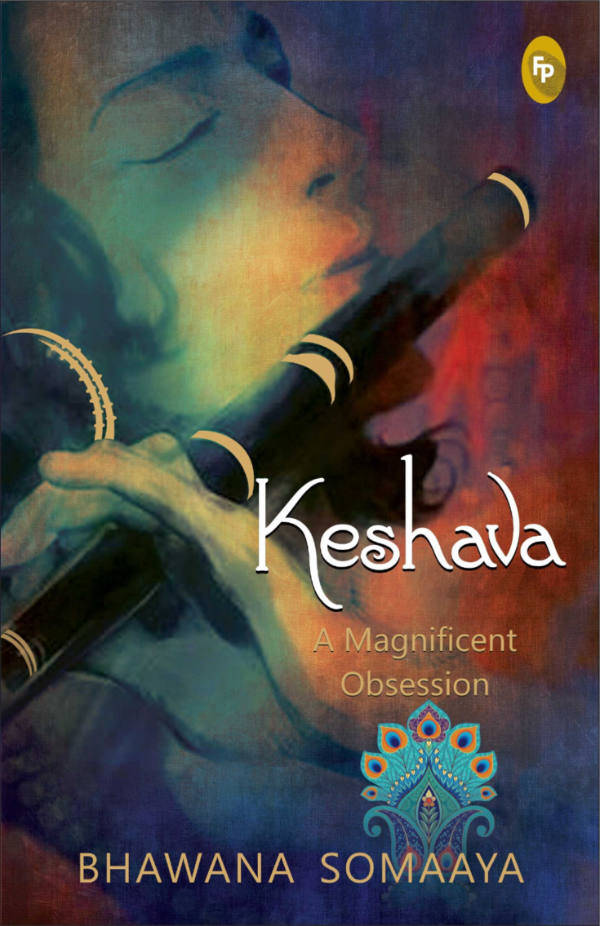
Paperback: 240 pages
Publisher: Fingerprint! Publishing
Release Date: 5 May 2018
Language: English
ISBN-13: 978-9387779396
Cover price: INR 299
For every lover of Krishna
There are devotees and then there are lovers. Bhawana Somaaya is among the latter. She has a self-confessed “obsession” called Lord Krishna that led her to write Keshava, A Magnificent Obsession.
When we think about Lord Krishna, what comes to mind first is the majestic Bhagavad Gita, that 700-verse epic delivered as counsel to Arjuna on the battlefield of Mahabharat. But people are also fond of the magical stories of his vibrant childhood (Balagopala) and youth: his endearing pranks, his fondness for butter, his affinity for playing the bansuri (flute), his charming disposition that won hearts of all the gopis (milkmaids) and, of course, Radha, his eternal love. These are the broad narratives of his life, of which all his devotees are aware to a great extent.
But Krishna’s lovers are not content with knowing about the grand adventures of his life. Their devotion makes them want to know the Lord ever more intimately. They want to know every small nuance about him—his different shades, his quirks and proclivities, his humanness and his divinity—in all its glory. This book is for such lovers of Krishna written by another fervent lover of the supreme deity.
Each chapter expands on ancient Sanskrit slokas (verses) and goes on to reveal many interesting tidbits from the life of Krishna. In the first chapter, Krishna is portrayed as describing himself from the eyes of his devotees.
Sample this:
“We are all projections of other people’s perceptions. I am no exception. Some perceive me as a child avatar. For them I am Balagopala, Balakrishna. Some view me as an eternal traveller. For them I am Banke Bihari. I was always there and will continue to be there. When I renounce my body, the surviving part of me will prevail amongst the five ingredients of nature. The sixth will be the heart of human beings.”
The following sections depict him from the vantage points of his most favourites things in the world—the peacock among birds, the lotus among flowers, the flute and the shankha (conch) among musical instruments, the Tulsi (holy basil) among plants, the Kadamba and the Peepala among trees, the Kamadhenu among cows. Each of them have a chapter dedicated to them, where they list their virtues and talk about the special place they enjoy in his heart, while also narrating enthralling legends of Krishna from their perspectives.
Tulsi, for instance, says:
“One day, when Lord Krishna’s youngest queen Satyabhama decided to weigh her husband in gold, all her wealth and ornaments could not tilt the scale. But then his older queen Rukmini Devi arrived with a plateful of my leaves. Older and wiser, she placed just a single leaf on the pan and the scale tilted—much to Satyabhama’s astonishment!
“Satyabhama question how could I be so precious and Rukmini Devi answered, ‘Because Lord Krishna so desired.’
“It is my Lord’s blessings that I am revered and every part of my being has a reason and a mission. My root, like every other plant, is for procreation but it is also symbolic for all the sacred places of pilgrimage. The centre of my stem is the dwelling place of all the deities and my upper branches are sacrosanct, for in them are embodied all the vedas.”
Tulsi continues:
“I am antibiotic. I offer antiviral and antifungal protection and I am useful in localised infections as well. I decrease the likelihood of strokes.
“I am nutritious. I contain Vitamin C and A, minerals calcium, zinc and iron, and chlorophyll and many other phytonutrients. I am also an allopathic medicine complement. I resolve dental and periodontal health, diminish bad breath and speed healing of bone fractures, reduce nausea and cramping, and repel insects, including mosquitoes and lice.”
While the style is a sweet blend of prose and poetry, and content is a mixture of myth and fact. The book is easy enough to read but profound in substance for those who are really paying attention.
This isn’t a book that you want to read from start to end, with the objective to finishing it. It’s a book to be savoured at a leisurely pace. Besides, it’s more fun to pick it up spontaneously and open a random chapter—doing so often answers a question you had been nurturing at a subconscious level.
To conclude, my sense is that whether you are a fervent lover of Keshava or his ardent devotee, or even simply fascinated by the divine nature of the supreme deity, this book is sure to delight you.

